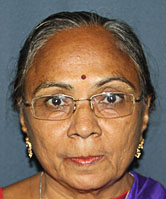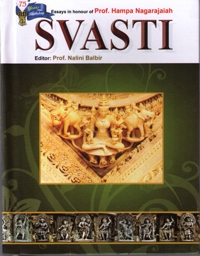23
Jain Devotionalism - The Namaskar Mantra
Qualities of the five Supreme Beings celebrated in the mantraThere are two modes of religious observance. (i) Devotional ii) Renunciatory. The devotional aspect involves acceptance of the Jina as the ultimate divinity. This taking refuge in the Jina and his path is formalized by initiation into the holy litany called pancanamaskara, reverent salutation to the five holy beings.
The Pancanamaskar Mantra, Namokar Mantra or Namaskar Mantra incorporates the five supreme beings who are saluted. The religious tradition of the Jainas is unique in many respects. In the Jaina tradition, it is customary to begin any work with the recitation of the Namaskara Mantra - the popular chant. It is the daily prayer of the Jainas. Recitation of Pancanamaskara comes to be synonymous with the acceptance of the Jaina Creed.
The Pancanamaskara is a Mantra, a litany (sacred formula) in which salutations are offered to the five Panca Parameshthis. Jainas adore the virtues of these five supreme beings. They are worshipped so that one can realize their virtues and become like them. Devotion to divine beings its the first step in spiritual progress. It contains salutations to the Arihantas, the Siddhas, the Acaryas, the Upadhyayas and the Sadhus. It is expressed in a prayer formula as follows:
- Namo Arihantanam (obeisance to the Arhats) - I bow down to Arihantas, the spiritual victors - the Jinas
- Namo Siddhanam (obeisance to Siddhas) - I bow down to the Siddhas (Disembodied liberated Souls). the accomplished ones who have attained Moksa.
- Namo Ayariyanam (obeisance to Acaryas) - I bow down to the mendicant leaders of the Jaina order.
- Namo Uvajjhayanam (Obeisance to Upadhyayas) - I bow down to the preceptors (mendicants)
- Namo Loe Savva Sahunam (Obeisance to all the Sadhus in the world) - I bow down to all the mendicants, the saints and sages everywhere in the world.
- Eso Panca Namokkaro - These five Salutations,
- Savva Pavappanasano - Erase all sin.
- Mangalanam ca Savvesim - Among all that is auspicious,
- Padhamam Havai Mangalam - It is the foremost (most auspicious).
Jaina devotionalism is directed towards five supreme beings or Panca Parameshthis who have attained the highest state and therefore are worthy of worship.
The early history of the Pancanamaskara Mantra is controversial. This litany occurs in the Kalpasutra - an extracanonical sacred book of the Jainas. According to the scholars, this formula occurs in the Mahanisihasutta. It also occurs in the Vasudevahindi and in the Satkhandagama. This sacred Jaina mantra is frequently found in Jaina ritual texts of later times. The European scholar W. Schubring is of the opinion that the only canonical reference to the formula was to be found in Mahanisihasutta. It is observed that originally, there existed the formula consisting of only two members, viz. Siddha and Jina who are invoked in the first verse of Pannavanasutta and also in the Bhagavai Sutta. Then the formula seems to be extended and we find the enlarged formula of five invocations.
- 12 Virtues of Arihantas
- 8 virtues of Siddhas
- 36 virtues of Acaryas
- 25 virtues of Upadhyayas
- 27 virtues of Sadhus - - - - - - - - - - - - - -Total - 108.
The first salutation is to Arihanta. The term ‘Arihanta’ is of great philosophical significance in Jainism. Arihanta is the one who has conquered inner enemies like pride, anger, deceit and greed. He is also the one who has destroyed four destructive karmas, viz. Knowledge-obscuring (Jnanavaraniya). Vision - (obscuring) (Darshanavaraniya), Deluding (Mohaniya), and obstructive (Antaraya) karmas. Freedom from these four kinds of karmas is the greatest achievement of an Arihanta. Acarya Kundakunda has said that one who knows the Arihanta in all its aspects knows himself.
The synonyms of Arihanta are:
- Jina - The conqueror
- Vitaraga - One who is free from passions i.e. who is dispassionate.
- Sarvjna - Omniscient
- Arhat - worthy of being worshipped.
The Arihantas possess twelve great virtues and they are devoid of eighteen vices such as hunger, thirst, anxiety, sleep, sorrow etc. An Arihanta deserves and commands respect and adoration because he is a worthy and holy being because of his virtues. It is said that one should meditate on the Arhat - the purified soul - who is endowed with vision, bliss, wisdom and energy. The Jina is praised by Pujyapada as a propounder of the way to ultimate release, as the destroyer of the mountains of karma and as the knower of the elements of universe. According to Acarya Haribhadra, an Arhat deserves respect and is honoured because he is the one whose Asravas, or defiling influxes, have been destroyed, one whose affliction, karmas and birth have been eradicated. He deserves salutation because of excellence in good qualities. Arihantas are free from ignorance, false belief, attachment, hatred, vowlessness, lust, fun, sorrow, delight. Hemacandra salutes the Arihanta by saying that he is a saviour who has constructed out of mercy the bridge to righteousness. According to Haribhadra, Arhatship includes perfection in yoga i.e. unity of true knowledge, faith and conduct. This kind of yoga results in union with ultimate release. Arihantas are devoid of passions that defile the soul. The Arihantas who are Jinas have in their lives personally lived the religion and showed the world the path of attainment of liberation.
12 Virtues of Arihanta:
4 main Atishayas (there are many of which 4 are important ones)
- jnanatishaya - specialty relating to supreme knowledge.
- Vacanatishaya - Arihantas deliver speeches/ sermons having 35 lofty ideal virtues such as specialties relating to speech (e.g. his speech is soft, clear etc.).
- Pujatishaya - specialty relating to worship - worthiness. Even Indras bow down to him.
- Apayagam - That which dispels 18 derogations e.g. sleep, ignorance, attachment, hatred etc.
8 Pratiharyas
1. Asoka Vrksa - 2. Puspa Vrsti - 3. Divya Dhvani - 4. Camar - 5. Sublime Seat - 6. Halo - 7. Divine Trumpet - 8. Chhatra.
These Pratiharyas are created naturally wherever a Jina goes.Functions of Arihanta (who is Tirhtankara):
The fact that the first salutation goes not to the perfected siddhas but rather to the Jinas - arhats is significant.
- The Arihanta expounds and establishes Dharma Sasana tirtha.
- The Arihanta preaches to the world what is Truth.
- The Arihanta shows to people the way to Salvation/ Moksa.
- He establishes the fourfold sangha. He ultimately becomes Siddha at the time of his Nirvana because at that time, he destroys the four remaining Aghati Karmas (Ayusya, Nama, Gotra, Vedaniya).
B) Siddhas (The Accomplished ones)
C) Acaryas (The Leaders of Jaina Order):They are the second group of the Panca Parameshthis. Siddha means one who has accomplished everything. He has been completely liberated from 8 Karmas, from the cycle of Birth and Death. Siddhas are beyond the world/ Samsara. They symbolize the supreme ideal of holiness and beatitude called Moksa. In the Jaina canon, Siddhas are indescribable. They are in disembodied state i.e. they have no body. They are without any shape, size, colour, smell and taste. They have accomplished everything and have nothing left to be realized. So Siddhas are Pure/ Perfect Souls. Jainism says that Siddhas are infinite. Their abode is at the top of the universe (Loka) in the Siddha Ksetra and they remain there forever. They are in Nirvana - in super bliss - release and awakened, liberated from all sufferings, having burnt the impurities of Karma. Such souls are super souls or siddha Parmatmas (liberated Super souls) as they theoretically possess the highest state of pure existence. Because of the destruction of all 8 Karmas, they possess 8 very important qualities as follows:
Every Siddha was once an ordinary human; hence, by meditating upon Siddhas, the Jaina aspirant is encouraged to pursue the path of purification.
D) Upadhyayas - (the Preceptors)They are the third group of Panca Parameshthis. They are spiritual leaders of the Jaina order. The master par excellence who guides the faithful in the practice of Jaina doctrine is called Acarya. Acarya is defined as the one who practices five Acaras - the five kinds of conduct and advises his disciples to do the same. These five kinds of practices are:
Acaryas are the ones who have disconnected bondage with family and the world and have become Munis. They pursue the path of liberation which has been expounded by Arihantas. They guide the laymen in organizing their conduct in such a way that it can lead to liberation. After mastering Agamas and attaining certain merits, they attain the status of Acarya through their teacher. After becoming Acarya they preach to the world.
Acaryas possess virtues:
E) Sadhus - (Sages-Monks)They form the fourth group of Panca Parameshthis. They are the instructors who are experts in teaching scriptures. They study Jaina scriptures with the guidance of spiritual heads (Acarya) and they attain the stage of Upadhyayas after becoming capable of teaching the doctrine of Jainism. These preceptors represent spiritual knowledge. They possess perfect knowledge, faith and conduct. From their teachings, a person can know his duties and regulate himself by practicing what is desirable. Their place is high among Jain sages as they directly encourage practice of religion by continually preaching the principles of religion.
Upadhyayas posses 25 Virtues:
Knowledge of 11 Angas and knowledge of 14 Purvas (important Purvas are lost). Upadhayas represent spiritual knowledge and they enlighten the people wandering in this world in the cycle of Birth and Death. The difference between Acarya and Upadhayaya is that Upadhyaya is expert in scriptural doctrines which he teaches and gives instructions about Dharma while the Acarya can issue a commandment of Dharma.
Other elements of the Pancanamaskara MantraA Sadhu is a good, righteous ascetic -a saint or a monk. Sadhus are the Parameshthis of the fifth group in descending order. Sadhus include Acaryas and Upadhyayas. They have discarded worldly life, which is full of infatuation and deception and they practice Tyaga. A Sadhu is the sage who practices good conduct which is pure and which leads to the path of liberation. He takes vow to observe great vows strictly throughout his life. Monks strictly practice the Acaras viz. Jnana, Darsana, Caritra, Tapa and Virya. In order to carry out these vows, they keep themselves fit. They renounce the world and obtain food through bhiksa. They are supposed to accept vegetarian pure food which is not prepared for them and which is not sold. They obtain food from devotees/ householders in such a way that they do not come in contact with water, fire. They accept food strictly following the prescribed rules. They do not have the responsibility of taking care of the household. They have totally renounced wealth, women and worldly pleasures. They are prohibited from even touching the opposite sex so that they can observe total non - attachment and celibacy.
Monks are not supposed to use any vehicle for traveling. They travel only on foot and wherever they stay, they spend time in acquiring knowledge and in doing meditation. They preach to the people, the high ideals such as non-violence, truth, noble conduct, charity, austerity, purity, benevolence, necessity of noble contemplation, and penance etc.
Qualities of Monks:
Sadhus possess 27 qualities as follows:
Duties of Sadhus:
Salutations are offered not only to Dravya sadhus but also to bhava Sadhus.
Though reverence to Panca Parameshthis is prescribed, it is really reverence to the soul of Parameshthis, which is to be meditated upon. Through this, the soul turns upon itself and meditates on its own nature, which is excellent meditation.
The total qualities of the Panca Parameshthis are 108. The Navkara Mantra is chanted 108 times. It has 9 Padas and 68 letters.
Special features of the Navakara Mantra“Om”.
This litany plays a great role in the mysticism of all Indian schools. This sacred syllable is present in the Yogashastra of Hemacandra. At the root of these words Om, Arham, there is the Navkara Mantra. Om (AAAum) contains the first letter of each Panca Parameshthi. These are concentrated forms of the Navkara Mantra. Repetition of Om thus becomes a legitimate practice for the Jainas.Meaning of Namo
The world Namo gives control over mind and victory over nature and it gives one energy to become a supreme soul different from an ordinary soul. It gives true knowledge about ones’ own soul.
Namo implies that friendliness is established. By namaskara, good acts become possible but it should be Bhava namaskara.
Scriptures give us knowledge of our own nature but a Mantra gives us the experience of our own soul. By uttering the Navakara Mantra, one can destroy sins.
- No sectarian bias: A person of any religion can recite it as it is the prayer of virtues and not the persons or God.
- No salutations are offered to an individual person but they are offered to his virtues. Also, no Jaina terms are used. No particular being, not even Mahavira, receives mention as the object of veneration. Jaina emotionalism is oriented towards an ideal. Hence reverence is given to all beings that have been in pursuit of that ideal. Jainism believes in adoration of virtues rather than in adoration of a person.
- Religious:
- It is most auspicious amongst all the auspicious mantras. It is a Mantra in which salutations are offered to 5 supreme beings who are auspicious.
- It destroys Karmas, thereby leading to spiritual progress.
- It destroys all impediments.
- It dispels obstacles.
- It exemplifies 14 Purvas (Scriptures).
- It is as good as getting the punyas of more than one Upavasa Vrata.
- Miraculous:
Many stories are told that underline the miraculous power of this Mantra. Two bullocks attained celestial existence by listening to this Mantra, a snake became a garland, fire became water, poison became nectar etc.
- Scientific:
From the scientific point of view, the power of this Mantra is extreme. Vibrations produced are such that peace of mind and equanimity are achieved. It heals physical and mental ailments.
- Comparison:
It is more powerful than the Kalpavrksa, the Cintamani or the Parasmani.
- Riddhi - Siddhi:
It gives worldly prosperities in addition to spiritual gains. The Navakara Mantra is the essence of Jina Sasana and is regarded as Maha Mantra (Greatest of all Mantras.)
It is significant to emphasize in conclusion the Jain conception of divinity. Jainism does not believe in personal God as a creator. Prayer is in the form of hymn - mantra - the simplest form of devotion used in the religion. But in Jainism prayer for asking something has no place. It is for becoming supreme soul - God. The soul becomes God by getting rid of passions. By praising the virtues of enlightened beings the self realizes its divine potentiality by his own efforts. Liberation is through self-efforts and not by grace of God. Incidentally, the term ‘Jainism’ is significant. It is derived from the term ‘Jina’ which means conqueror of inner enemies - (passions) The followers of ‘Jina’ are called Jainas. And the religion preached by Jina is Jainism. Jainas worship five supreme souls to attain their qualities. Hence it is said by Acarya Pujyapada:
“I Worship the leader of the road to salvation, Destroyer of mountains of karmas, knower of all the substance in the universe - to attain these qualities”.
 Dr. Kokila Shah
Dr. Kokila Shah

